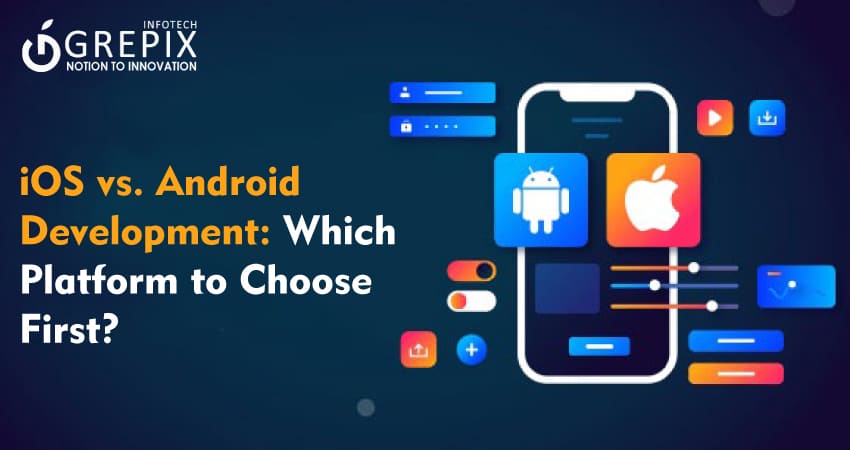iOS vs. Android Development: Which Platform to Choose First?
In the rapidly evolving world of mobile technology, app development has become a crucial skill for programmers and entrepreneurs alike. With billions of smartphones worldwide, the mobile app market presents a wealth of opportunities. However, one of the most significant decisions aspiring app developers face is choosing between iOS and Android platforms. Each platform has its unique set of advantages and challenges, and the choice can significantly impact the development process, target audience reach, and revenue potential. This article delves into the intricacies of iOS and Android development to help you make an informed decision on which platform to tackle first.
In the dynamic realm of mobile technology, choosing between iOS and Android development is pivotal for programmers and entrepreneurs due to the immense opportunities presented by the expansive smartphone market. Each platform, iOS with Swift and Objective-C and Android with Java and Kotlin, comes with distinct advantages regarding user demographics, revenue potential, and development nuances. iOS users, often from higher income brackets, are more likely to purchase apps, making iOS a lucrative option in profitable markets like North America and Western Europe. Conversely, Android dominates global market share, especially in emerging economies, offering a broader user base with varied monetization strategies like ads and in-app purchases. Factors like development tools, learning curves, and market reach are essential considerations. Ultimately, the choice depends on the specific goals and resources of the developer, with each platform providing unique challenges and opportunities.
Understanding iOS Development
1 Programming Languages and Tools
iOS app development primarily uses Swift and Objective-C programming languages. Swift, introduced by Apple in 2014, is a powerful and intuitive language designed to be user-friendly, making it an excellent choice for beginners. Objective-C, although older and less commonly used for new projects, is still relevant for maintaining and updating legacy codebases.
Xcode is the main iOS integrated development environment (IDE), accessible on macOS. A code editor, debugging tools, and an Interface Builder for creating user interfaces with Storyboard are all part of Xcode's extensive toolkit for developers.
2 Market Share and User Demographics
While Android holds a larger global market share, iOS dominates in certain regions like North America, Western Europe, and Australia. iOS users are often associated with higher income brackets and are more likely to spend money on apps and in-app purchases. This demographic tends to prefer high-quality, premium apps, which can be advantageous for developers focusing on monetization through direct sales.
3 Monetization Potential
Android and iOS typically offer higher average revenue per user (ARPU). Users who are willing to pay for apps and premium features are known to frequent the Apple App Store. Furthermore, a marketplace of high-quality apps is guaranteed by the App Store's stringent quality standards, which can increase developers' visibility and credibility.
4 Hardware Fragmentation
Apple's control over hardware and software results in a limited range of devices. This uniformity simplifies the development and testing process, as developers need to optimize their apps for fewer screen sizes and hardware configurations compared to Android.
5 Design Guidelines
Apple provides the Human Interface Guidelines (HIG), which offer comprehensive instructions on designing intuitive and user-friendly interfaces. Adhering to HIG can streamline the design process and improve the chances of app approval during the App Store review process.
Factors to Consider When Choosing a Platform
1 Target Audience and Market Reach
- iOS: If your target audience is primarily in regions with high iOS adoption or consists of users more likely to spend money on apps, starting with iOS may be beneficial.
- Android: If you aim to reach a global audience, especially in emerging markets, Android offers a broader user base.
2 Learning Curve and Programming Languages
- iOS: Swift is considered beginner-friendly, and Apple's cohesive ecosystem can make the learning process smoother.
- Android: Kotlin's modern features are appealing, but managing the diversity of Android devices may present a steeper learning curve.
3 Development Tools and Resources
- iOS: Requires a Mac for development due to Xcode's exclusivity to macOS. Apple's developer resources are comprehensive but may feel restrictive.
- Android: Android Studio is cross-platform, and the open-source nature of Android provides a wealth of community resources and libraries.
4 Revenue Models and Monetization Strategies
- iOS: Better suited for paid apps and in-app purchases, with users more inclined to spend money on premium features.
- Android: The user base comes from a variety of economic backgrounds, ad-based models and freemium strategies are more prevalent.
5 Device Fragmentation and Testing
- iOS: Fewer devices simplify testing and ensure consistent performance across the user base.
- Android: Requires extensive testing across multiple devices and OS versions, increasing development time and costs.
6 App Store Policies and Approval Process
- iOS: The App Store has a stringent review process, which can delay app releases but ensures a higher quality marketplace.
- Android: Google Play's more lenient policies allow faster deployment but may result in a more cluttered marketplace.
Pros and Cons of Starting with iOS
Pros
- Higher Revenue Potential: Greater likelihood of app purchases and in-app spending.
- Simplified Testing: Limited device models reduce the complexity of testing.
- Unified Ecosystem: Consistency across devices and OS versions.
- Strong Developer Support: Comprehensive documentation and support from Apple.
Cons
- Requires Mac Hardware: Necessitates investment in Apple hardware for development.
- Strict App Review Process: This can delay app launch and requires adherence to strict guidelines.
- Smaller Global Market Share: Limited reach in regions dominated by Android.
Pros and Cons of Starting with Android
Pros
- Wider Market Reach: Access to a global user base across diverse regions.
- Flexible Development Environment: Android Studio is available on multiple operating systems.
- Faster App Deployment: A less stringent review process accelerates time-to-market.
- Open-Source Platform: Greater flexibility and customization options.
Cons
- Device Fragmentation: Increased complexity in development and testing.
- Lower Revenue Per User: Users are less inclined to spend on apps and in-app purchases.
- Security Concerns: Open platforms can be more susceptible to security issues.
Recommendations Based on Different Scenarios
For Individual Developers and Startups
- Limited Resources: Starting with iOS may be more cost-effective due to simpler testing requirements.
- Revenue Focused: iOS could offer quicker returns on investment through higher user spending.
- Broad Audience Goals: If reaching a global audience is paramount, Android provides unparalleled access.
For Businesses and Enterprises
- Market Penetration: Developing for both platforms may be necessary to maximize reach.
- User Engagement: Consider where your target demographic spends more time and money.
- Strategic Rollout: Starting with one platform can allow for testing and refinement before expanding.
For Learning and Skill Development
- Ease of Learning: Swift's modern syntax may be more approachable for beginners.
- Versatility: Knowledge of Java or Kotlin can be advantageous due to their use beyond Android development.
Conclusion
Choosing the right platform for mobile app development whether iOS or Android depends heavily on a developer's specific goals, target audience, and resource availability. Grepix Infotech is a leading mobile app development company with expertise in both iOS and Android development and understands the unique advantages each platform offers. For developers aiming to quickly penetrate the market with a premium product and possibly higher earnings per user, iOS is a robust choice, particularly beneficial in regions with strong iOS market penetration and where users are more likely to pay for apps. Conversely, Android provides an unparalleled opportunity to reach a broader, more diverse global audience due to its dominant market share in many emerging markets and its open development environment, which facilitates a faster time-to-market.
Each platform presents distinct challenges and opportunities in terms of development tools, learning curves, monetization strategies, and market reach. For instance, iOS development demands a Mac and navigation through a strict app review process but offers a more unified and less fragmented testing environment. Android, while offering greater flexibility and a broader user base, requires addressing extensive device fragmentation and a potentially lower revenue per user.
Ultimately, the choice between starting with iOS or Android development should align with the developer's business strategy, technical preferences, and market research. Grepix Infotech recommends a native platform development approach when feasible, to maximize market penetration and cater to the diverse preferences of users globally. However, for those needing to choose one platform, consider your target demographic's location and spending habits, your technical expertise, and your budget constraints. Whether you choose iOS for its streamlined environment and higher revenue potential, or Android for its vast reach and flexibility, both platforms offer substantial opportunities for successful app development in the competitive tech landscape.
Launch your vision with our mobile app development company, where innovation meets excellence to create cutting-edge mobile solutions.








